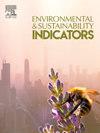平均物种丰度(MSA)与物种潜在消失率(PDF)之间的关系是一致的,但也存在不确定性
IF 5.4
Q1 ENVIRONMENTAL SCIENCES
引用次数: 0
摘要
物种潜在消失率(PDF)和平均物种丰度损失(MSA)是量化与商品和服务的生产和消费相关的当地生物多样性完整性损失(生物多样性“足迹”)的两个常用指标。然而,目前尚不清楚这两个指标在多大程度上一致。本文基于虚拟物种群落的模拟数据和受影响群落和参考群落(n = 19,891)的经验两两比较,探讨了MSA的损失是否以及如何与PDF相关。我们发现MSA损失与PDF之间存在显著的正但不确定的关系。根据经验数据,PDF使大约一半的MSA损失方差无法解释。我们的研究结果进一步强调了MSA损失和PDF揭示了社区变化的不同方面。在PDF为0时,MSA的平均下降幅度为0.20 (95% CI = 0.09-0.42),反映了丰度损失先于物种灭绝,MSA损失是生物多样性变化的一个更敏感的指标,特别是在低PDF值时。考虑到指标之间的内在差异和它们之间的关系存在较大的剩余异质性,我们认为MSA损失和PDF提供了互补的信息。我们建议根据应用程序的目标和范围对其中一个指标做出明智的选择,或者同时使用它们进行更全面的评估。本文章由计算机程序翻译,如有差异,请以英文原文为准。
Relationships between mean species abundance (MSA) and potentially disappeared fraction of species (PDF) are consistent but also uncertain
The potentially disappeared fraction of species (PDF) and the loss in mean species abundance (MSA) are two commonly used indicators to quantify losses in local biodiversity integrity associated with production and consumption of goods and services (biodiversity ‘footprints’). However, it is unclear to what extent these two indicators align. Here we explore if and how losses in MSA are related to PDF based on both simulated data from virtual species communities and empirical pairwise comparisons of impacted and reference communities (n = 19,891). We find a significant positive but uncertain relationship between MSA loss and PDF. Based on the empirical data, PDF leaves about half of the variance in MSA loss unexplained. Our results further highlight that MSA loss and PDF reveal distinct aspects of community change. At a PDF of zero, we find an average decline in MSA of 0.20 (95% CI = 0.09–0.42), reflecting that abundance loss precedes species extinction and that MSA loss is a more sensitive indicator of biodiversity change than PDF, particularly at low PDF values. Given the intrinsic differences between the indicators and the large residual heterogeneity in the relationship between them, we conclude that MSA loss and PDF provide complementary information. We recommend either making an informed choice for one of the indicators in view of the goals and scope of the application, or using them in parallel for a more comprehensive assessment.
求助全文
通过发布文献求助,成功后即可免费获取论文全文。
去求助
来源期刊

Environmental and Sustainability Indicators
Environmental Science-Environmental Science (miscellaneous)
CiteScore
7.80
自引率
2.30%
发文量
49
审稿时长
57 days
 求助内容:
求助内容: 应助结果提醒方式:
应助结果提醒方式:


